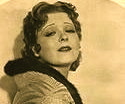Clara Bow

The “new woman” was in fashion throughout the twenties; this meant a woman who rejected the pieties (and often the politics) of the older generation, smoked and drank in public, had casual sex, and embraced consumer culture. Also called “flappers”, these women wore short skirts (at first just to the ankles, eventually up to the knees) and bobbed hair in a short cut – like a boy’s, but longer. Just as the flapper rejected the long hair popular in earlier years, she also discarded Victorian fashions, especially the corset, which accentuated women’s curves.
Flappers preferred to be slender, although it sometimes meant dieting or binding their breasts and wearing restrictive undergarments to appear thin, flat-chested, and long-limbed. Cultivating a flapper image and adhering to modern beauty standards also involved purchasing and applying cosmetics, which had not often been done previously by women other than prostitutes. These women further pushed the boundaries of what was considered proper for a woman by their public activities; swearing, smoking cigarettes, drinking alcohol (illegal from 1920 until 1933), dancing, and dating. The first appearance of the word “flapper” and the flapper image in the United States came from the popular 1920 Frances Marion movie, The Flapper, starring Olive Thomas. Thomas had starred in a similar role in 1917, though it was not until The Flapper that the term was used.
In her final movies she was seen in the flapper image. Other actresses, such as Clara Bow, Louise Brooks, Colleen Moore, and Joan Crawford would soon build their careers on the same image, achieving great popularity.
CLARA BOW: Love Among the Millionaires (1930)

http://en.wikipedia.org/wiki/History_of_women_in_the_United_States


